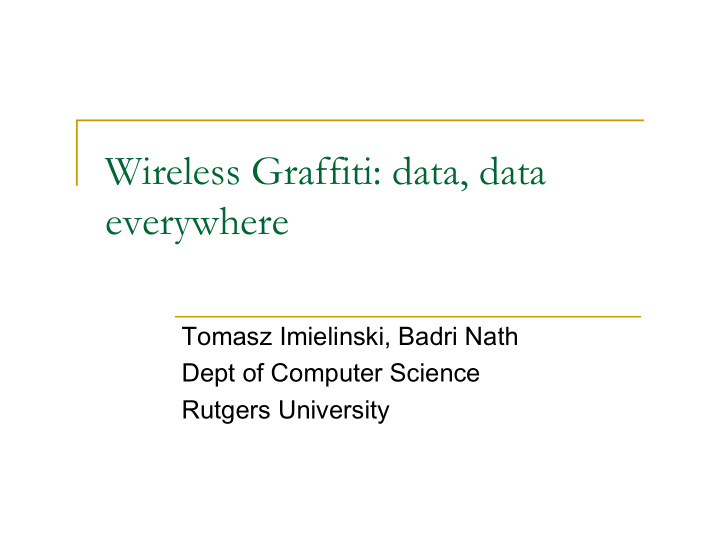



Wireless Graffiti: data, data everywhere Tomasz Imielinski, Badri Nath Dept of Computer Science Rutgers University
Phones then and now 600 grams 200 grams
Wireless Infrastructure PSTN Internet Internet IWF MSC BS BS BS
Issues in Wireless data management Location management n Massive number of users. 0.5 billion cell-phone users, Average 5 to n 10 million subscribers per carrier, 40 to 100 base stations Tracking mobile users q Search vs update tradeoff n Energy management n Typical power consumption (0.25 to 0.3 watts for Tx) and (0.08 to n 0.01 watts for Rx/standby mode) – Talk time 1.5 to 5 hours, 80 to 150 hours standby time (A factor of 1:30) Indexing to help devices switch off (standby) q Controlling doze mode q Bandwidth management n (9.2 Kbps [2G] to 54 Kbps [GPRS] to 1 Mbps [3G] -- Fixed 10 to n 100 Mbps already available) Broadcasting data q “Tune” to data without uplink requests q
Location management using areas/zones Track only at a zone/area granularity instead of a cell n Zones are determined adaptively on a per user basis (msg/mobility ratio) q Use other techniques to locate within a zone n Page, follow pointers, or an ordered search (most likely location first) q
Location-dependent querying Querying with location uncertainty n Give me doctors who are within 1 mile of the accident site q Search only if needed (constraints may eliminate zones) n Acquire data during query processing n Location constraints used to minimize cost n
Now, bragging time! Data on Air: Wireless Data q Streaming Energy efficient querying q and dissemination Client-proxy-server q architecture Disconnection q Geocast q CACM 94,SIGMOD 94, q EDBT 94… Mobidata q workshop Mobicom, mobile databases, Mobide
Now… What’s new now? n Miniaturization: Sensors, low power radios, MEMS technology n Location awareness n Finer granularity possible q Outdoor: GPS (within 20 meters accuracy, with correction from q DGPS, 5 meters accuracy possible) Indoor: triangulation using radio signal, acoustic, visual cues ( a q few feet but error management needed) Broadband n Bandwidth has improved (9 Kbps to 20 Kbps in wide area, 1 to 10 q Mbps in local area) Free spectrum usage (802.11, bluetooth, UWB etc, offers 1 to q 100 Mbps)
Blackboxes in every object n Blackbox records diagnostic data, performance data, history of the object q Planes …. Already there q Vehicles q Bridges and intersections q Cameras q Computers q Physical spaces (pollution, noise level, bandwidth availability, signal conditions) q Humans
What are the new applications? n Grassroots consumer reports n Intelligent Transportation: estimated travel time from A to B, road conditions, accidents n Space Capsules: correlate say medical data with location; how does the blood pressure of a patient change with location. Pollution history at specific location. n Location History Channel with replay
Querying/monitoring blackboxes n Provide average travel time for canal road within the last 10 minutes n Find average longevity of a battery in Lattitude X200 laptops n Available Bits/s on Wi-Fi along Spring Street in Soho n Notify me when the traffic jam near my house clears
Scenario: Data is with producers n Many consumers n Query and subscribe mechanisms n Mobility: Location of consumers and producers is changing n Data spaces as opposed to data bases n Peer to peer interaction
Why dataspaces? n Scalability n Information decentralization (minimal infrastructure) n Trust
What happens in dataspaces n Access to every object is over the network n Access methods have to use network primitives n Access plan and its cost may vary from object to object n Failure / disconnection is the norm rather than exception n Retry, reschedule primitive
Challenges of Dataspaces n Yellow pages or road signs? Database or Network as Query Engine? n Network indexes – multicast and group communication primitives used in query evaluation n Location Management for micro to macro scale
Conclusions n DataSpace – new challenge q It is geographic web – this time we can do it “right” q Merger of (spatial) databases and networking - who does what? Querying, caching, recovery and disconnection, quality of service q Databases “on the road”?
Recommend
More recommend